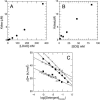Effect of detergents on the association of the glycophorin a transmembrane helix
- PMID: 14581210
- PMCID: PMC1303586
- DOI: 10.1016/S0006-3495(03)74728-6
Effect of detergents on the association of the glycophorin a transmembrane helix
Abstract
We have examined the role of the environment on the interactions between transmembrane helices using, as a model system, the dimerization of the glycophorin A transmembrane helix. In this study we have focused on micellar environments and have examined a series of detergents that include a range of alkyl chain lengths, combined with ionic, zwitterionic, and nonionic headgroups. For each we have measured how the apparent equilibrium constant depends on the detergent concentration. In two detergents we also measured the thermal sensitivity of the equilibrium constant, from which we derive the van't Hoff enthalpy and entropy. We show that several simple models are inadequate for explaining our results; however, models that include the effect of detergent concentration on detergent binding are able to account for our measurements. Our analysis suggests that the effects of detergents on helix association are due to a pair of opposing effects: an enthalpic effect, which drives association as the detergent concentration is increased and which is sensitive to the chemical nature of the detergent headgroup, opposed by an entropic effect, which drives peptide dissociation as the detergent concentration is raised. Our results also indicate that the monomer-monomer interface is relatively hydrophilic and that association within detergent micelles is driven by the enthalpy change. The wide variations in glycophorin a dimmer, stability with the detergent used, together with the realization that this results from the balance between two opposing effects, suggests that detergents might be selected that drive association rather than dissociation of peptide dimers.
Figures



Similar articles
-
Detergents modulate dimerization, but not helicity, of the glycophorin A transmembrane domain.J Mol Biol. 1999 Oct 29;293(3):639-51. doi: 10.1006/jmbi.1999.3126. J Mol Biol. 1999. PMID: 10543956
-
Sequence-specific dimerization of a transmembrane helix in amphipol A8-35.PLoS One. 2014 Oct 27;9(10):e110970. doi: 10.1371/journal.pone.0110970. eCollection 2014. PLoS One. 2014. PMID: 25347769 Free PMC article.
-
A method for determining transmembrane helix association and orientation in detergent micelles using small angle x-ray scattering.Biophys J. 1999 Aug;77(2):1064-73. doi: 10.1016/S0006-3495(99)76956-0. Biophys J. 1999. PMID: 10423450 Free PMC article.
-
Dimerization of glycophorin A transmembrane helices: mutagenesis and modeling.Soc Gen Physiol Ser. 1993;48:11-21. Soc Gen Physiol Ser. 1993. PMID: 8503039 Review. No abstract available.
-
Lipopeptide detergents for membrane protein studies.Curr Opin Struct Biol. 2009 Aug;19(4):379-85. doi: 10.1016/j.sbi.2009.07.008. Epub 2009 Aug 12. Curr Opin Struct Biol. 2009. PMID: 19682888 Review.
Cited by
-
Solution NMR: A powerful tool for structural and functional studies of membrane proteins in reconstituted environments.J Biol Chem. 2019 Nov 1;294(44):15914-15931. doi: 10.1074/jbc.REV119.009178. Epub 2019 Sep 24. J Biol Chem. 2019. PMID: 31551353 Free PMC article. Review.
-
Amide vibrations are delocalized across the hydrophobic interface of a transmembrane helix dimer.Proc Natl Acad Sci U S A. 2006 Nov 7;103(45):16740-5. doi: 10.1073/pnas.0608243103. Epub 2006 Oct 30. Proc Natl Acad Sci U S A. 2006. PMID: 17075037 Free PMC article.
-
Dimerization of the EphA1 receptor tyrosine kinase transmembrane domain: Insights into the mechanism of receptor activation.Biochemistry. 2014 Oct 28;53(42):6641-52. doi: 10.1021/bi500800x. Epub 2014 Oct 17. Biochemistry. 2014. PMID: 25286141 Free PMC article.
-
Molecular Dynamics Simulations of Micelle Formation around Dimeric Glycophorin A Transmembrane Helices.Biophys J. 2004 Aug;87(2):754-63. doi: 10.1529/biophysj.104.040279. Biophys J. 2004. PMID: 15298884 Free PMC article.
-
Analytical ultracentrifugation sedimentation velocity for the characterization of detergent-solubilized membrane proteins Ca++-ATPase and ExbB.J Biol Phys. 2007 Dec;33(5-6):399-419. doi: 10.1007/s10867-008-9058-3. Epub 2008 Apr 25. J Biol Phys. 2007. PMID: 19669527 Free PMC article.
References
-
- Bond, P. J., and M. S. P. Sansom. 2003. Membrane protein dynamics versus environment: simulations of OmpA in a micelle and in a bilayer. J. Mol. Biol. 329:1035–1053. - PubMed
-
- Booth, P. J., R. H. Templer, W. Meijberg, S. J. Allen, A. R. Curran, and M. Lorch. 2001. In vitro studies of membrane protein folding. Crit. Rev. Biochem. Mol. Biol. 36:501–603. - PubMed
-
- Bormann, B. J., W. J. Knowles, and V. T. Marchesi. 1989. Synthetic peptides mimic the assembly of transmembrane glycoproteins. J. Biol. Chem. 264:4033–4037. - PubMed
Publication types
MeSH terms
Substances
LinkOut - more resources
Full Text Sources

